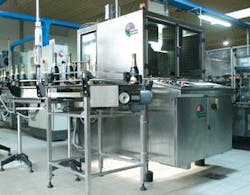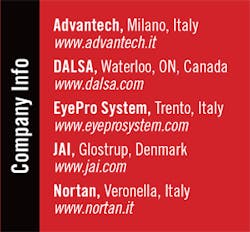Vision system checks for defective wine labels
The Ferrari Winery fills up to 10,000 bottles per hour. The winery owners determined that they needed an automated solution to inspect the labels on the bottles and fill level to keep up with production. Ferrari turned to vision-system designer EyePro Systems to develop an automated system that checks the bottles around the entire circumference; locates, verifies, and measures the position of the front and back label; reads the barcode on the back and checks it against production schedules to verify the right vintage; and checks the fill level inside the bottle. To maintain throughput, the system has to inspect the bottles as they move down the production line.
EyePro developed the Q-Label inspection system (Quality Label). It inspects the bottles with a rotating conveyor system from Nortan and a pair of JAI M10 dual-tap monochrome cameras connected to a DALSA Viper four-channel IC_ASYNC frame grabber, as well as a digital I/O board to communicate with downstream PLCs mounted inside an industrial PC for image processing (see Fig. 1).
Sparkling Image
Within a 0.5-m inspection window, the EyePro system inspects the entire surface and appearance of the bottles and provides in-line control of the integrity, shape, conformity, position, and alignment of the bottles’ labels, caps, stamps, marks, and decorations with resolution of ~0.5 mm (based on customer requirements, optics, camera resolution, and stand-off distance). All of this is done without suspending or changing the flow of wine into the bottles being filled at a rate of up to 10,000 per hour.
Bottles enter Q-Label one at a time via a wire-rack feeding conveyor from Nortan, a manufacturer of wire-rack and sleeve material-handling systems for bottling operations. As the bottles enter the inspection station, they are fed onto a rotating conveyor that carries the bottles through the inspection station while rotating them a minimum of 360˚ within the inspection system’s 0.5-m length.
A bank of standard fluorescent lights, chosen for their cost-effectiveness and ease of replacement, is on one side of the inspection station with a few additional lights placed on the far side for backlighting the fill-level inspection procedure. All lights are continuously energized when the system is in operation and positioned so that stainless-steel baffles diffuse the light. According to EyePro system-designer Andrea Bertuolo, the lights are positioned off-axis to minimize reflections from the bottle surface and reduce hot spots while providing sufficient light for the inspection system.
Once the operator sets the system into operation and selects an inspection procedure or ‘recipe,’ the system inspects each bottle’s label without a trigger mechanism. This is accomplished by using cameras that work at high speeds, guaranteeing that the ‘right’ image-showing a complete instead of partial label-is available for processing. While this may introduce additional expense at the camera level, it greatly simplifies triggering and material-handling systems, which more than makes up the difference in cost while accommodating future increases in throughput speeds.
Finding the Right Image
A pair of M10, dual-tap monochrome CCD cameras from JAI are mounted at the same side as the light bank and collect images of the passing bottles at 50 frames/s. The M10 gray-scale progressive-scan cameras are connected to a DALSA four-channel IC_ASYNC board (previously Coreco Viper board). Each channel of the four-channel board has its own 1K × 1K linear frame buffer, independent external trigger, frame reset, strobe, sync, timebase settings, and input conditioning circuitry to maximize speed and product throughput (see Fig. 2).
According to Bertuolo, when the system was installed, it required two M10 CCD cameras at 782 × 582-pixel resolution to cover the entire 0.5-m inspection window with an image resolution of 0.5 mm. EyePro is working to retrofit the Ferrari installation with higher-resolution DALSA Piranha2 trilinear color cameras with Camera Link interface. In addition to adding color to EyePro’s inspection capabilities, Bertuolo says the new cameras with Camera Link interface will have significantly higher image-acquisition speed and bandwidth to send the images back to the industrial PC, while meeting the company’s goals of fielding equipment with vendor support of seven years or more.
Images are collected in a memory buffer in the four-channel frame grabber before being passed to the PC RAM and the Q-Label software. Written in C and C++, Q-label provides a graphic user interface that allows an operator to easily pick and choose among inspection recipes or alter a recipe as needed by adding, subtracting, or changing the region of interest and altering thresholds such as misalignment rejection or fill level. All operations are created and initiated through a touch screen (Pro-Face or Advantech); however, the industrial PC host also has keyboard connectivity, should the user prefer to interface with the system in this fashion (see Fig. 3).
Q-label uses pattern searches to locate the labels in acquired images and template matching for full label verification. Inspection tasks include height and inclination of the front and back label, label integrity to guard against tears and rips, bottle-cap presence and location, fill level inside the bottle, and barcode verification of the label against the plant’s manufacturing database. After all the physical parameters are located and checked and positional accuracy confirmed to within 1 mm, the information is stored locally on the hard drive in a SQL database. For installations using more than one EyePro system, data also can be sent across the system’s internal Ethernet connection to an EyePro SQL database located on a central server.
The Q-Label system verifies the barcode and lot-code numbers on each bottle. When a bottle fails to meet Ferrari’s requirements, EyePro sends a trigger signal to a downstream hydraulic reject PLC arm to move the bottle out of the production line. The PLC reads the barcode on the defective bottle and takes action.
“Using this system, we are now able to maintain higher quality standards in the dressing of our bottles, which is crucial to marketing and selling our wine,” said Marcello Lunelli, technical director of Ferrari Winery. “By introducing the Q-Label machine in our plant, we have also made changes and improved our process over time due to the objective data provided by the inspection machine. In less than one year, we have received payback on our investment in this system.”
In addition to adding color to the EyePro for Ferrari’s bottling inspection line, the company offers additional software modules that can verify the position and integrity of the cork and can identify impurities floating inside the bottle. “We design our software in application-specific modules so that companies can pick and choose exactly what they need for their inspection system. That modularity plus our dedication to lifetime support of robust vision systems are our business model,” Bertuolo concludes.
null




